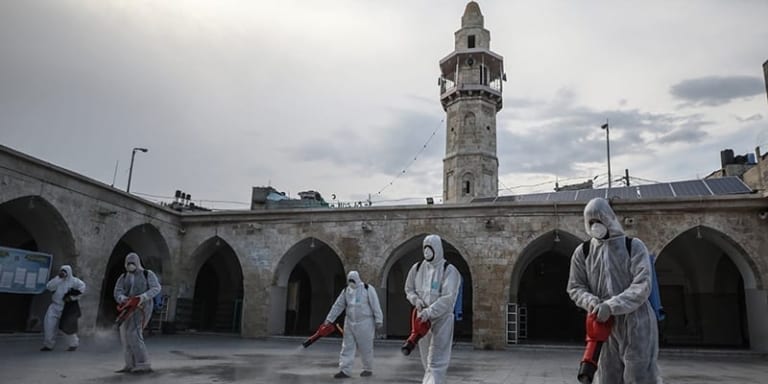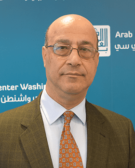
Table of Contents
• Introduction
• COVID-19 Exposes the Information Crisis and Digital Inequality in the Arab World
• Two Unwelcome Repercussions of the Coronavirus in the Gulf Cooperation Council
• Response to the Coronavirus in the Levant Reveals Certain Sectarian Elements
• The Political Nature of Egypt’s Coronavirus Management
• The Common Threat from COVID-19 Will Not Change Israeli Policy
• COVID-19 and the Fragile Economies of the Middle East
Introduction
By March 23, the Arab world had reported 3,449 cases of infection and 75 total fatalities1 from COVID-19, the disease caused by the novel coronavirus. The rates of infection have been higher in some countries than others, although there is no full certainty about numbers in any one or cluster of countries. There also is concern about the ability of individual governments to effectively test for, detect, and fight the virus. For different reasons, three Arab countries have not yet reported any cases: Libya, Comoros, and Yemen. However, that does not necessarily mean that they do not have undetected cases. To minimize infections and person-to-person transmission of the virus, government responses have ranged from strict closures of airports and other ports of entry to the imposition of regulations rising to the level of states of emergency to impede people’s freedom of movement.
Considering the poor political and economic conditions facing the Arab region and the civil wars ravaging some of the countries there, it is expected that efforts to respond to the disease will be more successful in some states than in others. But leaders and governments should spare no means to organize in-country responses to protect their own citizens and take part in the global effort to stem the spread and transmission of the disease. Factors such as limited technical knowhow and technological expertise, poor human and financial resources, and bureaucratic inefficiency are bound to be serious impediments. Nevertheless, if Arab governments want to avoid a calamitous outcome from the virus in their communities, they should be careful not to treat it as merely a passing cloud with a fleeting and temporary effect. It is also essential that efforts include a careful, targeted, and efficient mitigation of the impact of the virus and infections on millions of refugees around the Arab world who are the most vulnerable at this difficult time.
Arab Center Washington DC asked its resident and non-resident fellows and scholars to investigate and report on the different aspects of this global public health issue. Their responses are below. More future coverage will be provided as conditions warrant.
COVID-19 Exposes the Information Crisis and Digital Inequality in the Arab World
Tamara Kharroub, Senior Fellow, Arab Center Washington DC
The COVID-19 pandemic has uncovered the possibilities as well as the confines of internet and communication technologies as millions of people around the world are homebound, employees are teleworking, students are taking virtual classes, and information on social media platforms about the novel coronavirus abounds. While virtual learning and telework in the Middle East have been enabled greatly by the availability and access to technological tools and connectivity, these unusual conditions have shed further light on inequality, misinformation, and authoritarianism in the region.
First, this overreliance on the internet and communication tools exposed the extent of the digital divide whereby the gap that exists—between individuals, communities, countries, or regions—in the access to information and communication technologies determines their ability to work remotely or access educational resources. According to the International Telecommunication Union, internet users in Arab states comprised 51.6 percent of the population in 2019, leaving almost half of the Arab world disconnected. The digital divide not only refers to accessibility but also the quality of access, such as the availability of broadband or high speed internet, which allows for a better connectivity experience. During this period of the COVID-19 societal shutdown, which might last for several weeks if not months, those without access and quality access will lag, including school and college students and workers. As the effects of this crisis are expected to be long-lasting, work and education will be heavily dictated by and dependent on access to technologies. With the persistent high costs of quality digital services, the digital divide will further exacerbate educational and socioeconomic inequality in the Arab world in the long run. This will be more felt in countries with higher digital divides like those in North Africa and the Levant, compared to wealthy countries in the Gulf. What this pandemic has revealed is the vital importance of increasing the quantity and quality of digital access and reducing costs across the region.
Second, one of the aspects of the second-level digital divide addresses the notion of the knowledge divide, where individuals who do not have access to the needed skills to use technology are at a disadvantage in terms of access to information. For example, those with lower levels of education and technical skills are less likely to be able to identify the credibility of sources and are prone to health risks by following false guidelines and information about the novel coronavirus. In fact, an abundance of false information is available online, prompting the World Health Organization to warn of a fake news “infodemic.” The knowledge divide in the case of COVID-19 can manifest through susceptibility to false information, conspiracy theories, and propaganda tactics. The outbreak has been weaponized to stoke sectarian Sunni-Shia tensions online and inflame political conflicts like the GCC crisis. For example, the Saudi and Emirati Twitter spheres are rife with posts that blame Qatar for the coronavirus, claiming it manufactured the virus in China in order to jeopardize Saudi Vision 2030 and Dubai Expo 2020, using the hashtag in Arabic “Qatar is corona.”2 Others attribute the spread of the virus in Iran to what they call “Shia backwardness,” referencing practices such as licking shrines. This type of misinformation and propaganda will likely activate religious and political conflict and prejudice while galvanizing hatred and stigmatization and increasing public health risks. Although tech companies like Facebook, Google, and Twitter are trying to respond quickly and ban false posts, the spread of misinformation on social media and other applications like WhatsApp seems to be exceeding their speed and ability yet again (and even those of officials). More so, social media algorithms are failing and are erroneously banning legitimate posts about COVID-19 (e.g., Facebook), potentially blocking life-saving information. The (understandable) lack of trust in governments in the Arab world further limits their ability to correct false online information. Once again, social media can play a critical role in fueling xenophobia, conflict, and risks to life. In an era of social distancing and increased reliance on online tools, this further underscores the need for a serious multinational effort to address the spread of misinformation, disinformation, and hate speech over social media platforms. It also exposes the need for Arab governments to focus on technical skills training, media literacy, and transparency.
Third, this state of emergency has encouraged and justified draconian measures including surveillance of citizens, restraints on the freedom of expression, and erosion of rights. For example, Israeli Prime Minister Benjamin Netanyahu announced that the Shin Bet––Israel’s internal security agency––would use counterterrorism technology to track COVID-19 patients. While Israel already uses such measures to unlawfully monitor Palestinians, this step serves to legitimize and rationalize similar steps by the Palestinian Authority and other Arab regimes to infringe on privacy rights. Israel also only distributed information on the coronavirus in Hebrew for weeks, leaving out its Arabic-speaking Palestinian citizens, and arrested those who attempted to distribute information in East Jerusalem. In Egypt, and in the midst of a media blackout on cases there, the government has revoked press credentials of journalists for citing epidemiologists who estimated more than 19,000 COVID-19 infections in the country. It is clear that the outbreak is being exploited for political ends, with little regard for the rights of citizens and freedom of expression. In the final analysis, it is those in poor, marginalized, and oppressed communities who will pay the highest price and will suffer the most in long-term consequences. To be sure, Arab governments need to prepare for a lasting and unpredictable pandemic. They should plan to formulate and implement measures that ensure equal access to technology and credible information for all their citizens.
Two Unwelcome Repercussions of the Coronavirus in the Gulf Cooperation Council
Imad K. Harb, Director of Research, Arab Center Washington DC
The GCC countries (Bahrain, Kuwait, Oman, Qatar, Saudi Arabia, and the United Arab Emirates) have been heavily impacted by the virus in the Arab world. As of March 23, Bahrain has reported 339 cases and 2 deaths, Kuwait 189 cases and 0 deaths, Oman 66 cases and 0 deaths, Qatar 494 cases and 0 deaths, Saudi Arabia 511cases and 0 deaths, and the UAE 153 cases and 2 deaths. Despite being financially more comfortable than many other countries in the Arab world, the recent steep drop in oil prices will no doubt impact the GCC countries’ response and future economic well-being. Important questions remain: will they need to implement more drastic measures than they already have put into force? How fast will their institutions be able to readjust in the period following the passing of the current dark cloud?
GCC states have a special demographic situation as a result of the presence of tens of millions of expatriate workers who are employed in all skilled and unskilled occupations in the Gulf region. On the one hand, these workers can make GCC states’ efforts to fight the virus more difficult simply because they increase both the number of those susceptible to the disease and the cost of monitoring and treating them. On the other hand, if this crisis extends for a period during which their employers suffer irredeemable financial losses because of slower economic activity, they could fall victim to widespread furloughs followed by repatriation to their countries of origin. While there has been no clear breakdown of the spread of COVID-19 among the national populations of the GCC countries and their expatriate workforces, one can safely speculate that infections are disproportionately higher among the latter. Guaranteed health benefits and work contract protections may not be sufficient to make up for the crowded living conditions that arguably guarantee high infection rates among these guest workers.
As to the GCC states’ responses to the coronavirus pandemic, they have been uniform regarding movement, travel, and entry. All have suspended inbound flights, some from specific countries, while others, like Oman, ended visa issuance to non-nationals. Saudi Arabia even discontinued domestic air travel, bus and taxi services, and trains for at least two weeks. It also ended private sector work for two weeks. Perhaps the most consequential response has been the suspension by Saudi Arabia—the quintessential proto-religious state—of prayer services in mosques across the kingdom, including the two holy mosques in Mecca and Medina. Riyadh also suspended the Umrah, the shorter version of the Hajj pilgrimage performed by Muslims throughout the year. The worry now is whether the Hajj season itself––set for late July to early August 2020––will take place this year. On two previous occasions, in 1821 and 1865, cholera outbreaks among visitors to the holy shrines killed 20,000 and 15,000 pilgrims, respectively. A potential outbreak of COVID-19 among some two million customary visitors to Mecca this year would be catastrophic.
Response to the Coronavirus in the Levant Reveals Certain Sectarian Elements
Joe Macaron, Senior Fellow, Arab Center Washington DC
The Levant countries of Lebanon, Syria, Iraq, and Jordan had no shortage of crises before the coronavirus outbreak, including regional conflicts, large numbers of refugees, and inadequate public services. The first three countries were concerned about the virus because of their regular contacts with Iran, where over 23,000 cases of infection have been reported and more than 1,800 persons have died. All of these countries declared national emergencies by mid-March but did not act swiftly to ban border entries. However, actual COVID-19 cases were relatively limited, which eased the pressure on hospitals that are not equipped to handle a pandemic. A massive outbreak could potentially overload a health sector that lacks enough testing and respiratory equipment.
Coronavirus infection cases were detected in Lebanon and Iraq in the last ten days of February. Both governments were lax in handling the situation in the beginning but then became proactive, imposing restrictions on movement by enacting state of emergency measures. Since Jordan does not regularly interact with Iran, the first coronavirus case was detected relatively late, on March 2, and the source of transmission came from Italy. Jordan, with about 127 cases so far but no deaths, imposed medical tests on the border. A national defense law took effect on March 17, which allowed the deployment of the Jordanian army and gave the government absolute authority to ensure public safety.
The public debate on the coronavirus became embroiled in political and sectarian tensions. In Lebanon, where 267 cases were confirmed and 4 deaths announced, there were questions about whether the source of the virus transmission was from Iran or Italy and if some infected Christian areas should be isolated. In Iraq, where 266 cases were confirmed and 23 deaths announced, the coronavirus crisis has strained the already complicated relationship between the central government in Baghdad and the Kurdish Regional Government in Irbil. The Syrian regime’s health minister, Nizar al-Yazigi, politicized the public health crisis by saying that there were no cases to date and boasting that “Thank God, the Syrian Army has cleansed many of the germs that were present on Syrian soil.” Still Syria announced one case of infection on March 23.
Surprisingly, the Syrian regime is in denial, claiming no COVID-19 cases despite its regular interaction with both Iran and China. There are concerns that the regime might be deliberately hiding outbreak data, including among detainees. Across Syria, there is a shortage of adequate medical care and testing equipment. Beyond announcing preventive measures and imposing a curfew on March 14, there is little the Kurdish-led Autonomous Administration of North and East Syria (Rojava) can do if coronavirus cases begin to emerge. Moreover, 1.5 million Syrians who fled Idlib after recent Syrian-Turkish tensions have established arbitrary camps and settled in highly dense areas near the Turkish border, making a potential outbreak real at a time when COVID-19 cases are on the rise in neighboring Turkey. The World Health Organization is currently providing testing and prevention equipment both in northwestern Syria and in territories under the Syrian regime’s control. If not swiftly addressed, these cases across Syria could potentially spin out of control and impact neighboring countries as well.
The Political Nature of Egypt’s Coronavirus Management
Khalil al-Anani, Senior Fellow, Arab Center Washington DC
The response of the Egyptian authorities to the coronavirus has been marked by ambiguity, lack of transparency, and inefficiency. In the beginning of the outbreak in Egypt, the government denied the existence of the virus.3 It was not until the end of February 2020 that seven foreign tourists from Canada and France tested positive after returning from a Nile cruise. Since then the Egyptian Ministry of Health began reporting cases and providing updates on a daily basis. Still, there is public skepticism about real figures. The government has so far reported 327 cases and 14 deaths, some of which involve foreign tourists. A controversial study published by infectious disease specialists from the University of Toronto and reported by The Guardian suggested that Egypt might have more than 19,000 cases. However, Egyptian authorities have vehemently denied that number and revoked the press credentials of The Guardian’s reporter. Furthermore, while media reports speculate that Egypt can be a “new center of coronavirus,” the government suppresses these reports and considers them “rumors” that are aimed at the state.
To mitigate the ramifications of COVID-19 and to contain its spread across the country, Egyptian authorities announced a suspension of all flights to and from Egypt’s airports between March 19 and 31, 2020. They also closed schools and universities for two weeks starting March 15. Despite these procedures and precautions, Egyptians are in a panic and have rushed to stock up on essentials. What is particularly worrisome is the condition of thousands of political detainees in the country. The government is rejecting calls to release prisoners; recently, security forces arrested a group of activists who protested “over fears of a coronavirus outbreak in the country’s overcrowded jails.”
Elsewhere in North Africa, COVID-19 cases have increased over the past few weeks. In Morocco, around 143 cases are reported with 4 deaths, and in Algeria, there are 230 cases with 17 deaths (the numbers are on the rise daily). Both countries closed mosques and suspended prayers and shut down their borders. Similarly, Tunisia imposed a curfew from 6 p.m. to 6 a.m. starting Wednesday, March 18 in order to confront the virus which has afflicted 89 people and killed 3. Even in Libya, a country is embroiled in civil war, the fight between different factions has been affected by the coronavirus.
The Common Threat from COVID-19 Will Not Change Israeli Policy
Khalil E. Jahshan, Executive Director, Arab Center Washington DC
Since its identification last December in Wuhan, China, the coronavirus pandemic has spread to 195 countries, infecting more than 372,699 persons and killing over 16,314 worldwide. The fast-spreading virus clearly knows no geographic, ethnic, or political boundaries. Like other regions of the world, the Middle East has had its share of reported cases, including many in Israel and Palestine.
With 1,442 confirmed cases in Israel and another 59 cases in Palestine (the occupied West Bank and Gaza Strip), both the Israeli and Palestinian health authorities have moved quickly and adopted strict emergency measures ranging from social distancing, shutting schools and other public facilities, restricting internal and external travel, and banning large gatherings to contain and mitigate the spread of the deadly virus.
Beyond its alarming global threat to public health and the world economy, a pandemic like the coronavirus holds certain unforeseen circumstances, both positive and negative in nature. On the positive side, for example, the Palestinian Authority (PA) and the Israeli military’s Coordinator of Government Activities in the Territories—in charge of the occupation—surprisingly set up a joint operations room to coordinate their collective response. The shared threat of the virus seems to have scared both sides enough to mollify the historic enmity and trust deficit between them and generate a modicum of cooperation. This included exchanging test kits, supplying large quantities of medical equipment and products to the PA and Gaza, transferring patients in serious condition, sharing test results, and facilitating the evacuation of foreign tourists to airports. One is tempted to assume that Palestinian-Israeli cooperation in fighting COVID-19 brought the one-state solution a step closer to reality.
In another equally surprising step to stem the diffusion of the coronavirus, the Israeli Ministry of Defense, currently headed by “New Right” hardliner Naftali Bennett, waived—for several weeks—security restrictions that normally prevent Palestinian workers from spending the night within the Green Line. These are laborers employed by various Israeli industries such as agriculture, construction, health, and manufacturing. The waiver, particularly on such a large scale, has been quite rare since Israel’s 1967 occupation of the West Bank.
The common fear of the coronavirus outbreak, however, did not help to advance the peaceful resolution to the Palestinian-Israeli conflict. The rare joint cooperation in combating COVID-19 apparently was not effective enough to apply to all aspects of life in occupied Palestine. On the negative side, the Israeli occupation continued to display its routine sadistic and oppressive encroachment on Palestinian daily life. The global health emergency failed to slow down the pace of illegal Israeli annexation of Palestinian land, home demolitions, unjustified Israeli police raids on Palestinian towns like al-Isawiya, arbitrary arrests, collective punishment, state-sanctioned settler terrorism against Palestinian farmers, and even the defiance of anti-coronavirus measures undertaken by Palestinian police in their assigned areas of control.
Inside Israel, according to civil society activists, “weeks after the coronavirus outbreak began, Israel’s Health Ministry had yet to publish Arabic guidance on its website” to inform one-fifth of its population about the threatening pandemic—despite the fact, in addition, that more than 17 percent of all doctors and medical staff in Israel are Palestinians. The ultimate in Israeli ugliness occurred on March 23, 2020 with Israeli media reports that the Netanyahu government was about to close “the Shoafat border checkpoint in East Jerusalem,” a move that, according to Haaretz, would practically deprive 70,000-100,000 Palestinians, who are permanent residents of Israel, of health services offered within the municipality of Jerusalem to combat the spread of the coronavirus. Such a measure illustrates the policy of “separate and unequal” which is the classic definition of apartheid.
More ominous to both Palestinians and Jews in Israel, the Netanyahu government cast aside hardly won civil liberties and ignored the legislative power of the Knesset by approving national regulations permitting mass surveillance of coronavirus patients, Palestinian and Jewish citizens alike, by tracking their cellphones without court order. This led to a broad campaign by Israeli civil rights activists accusing Netanyahu of taking advantage of the COVID-19 scare to carry out a “massive power grab,” including shutting down both the Knesset and the court system in Israel.
Fear of manipulating the health crisis for narrow political gains is not limited to Israel but is also shared by some in Palestinian civil society. In an interesting article in Haaretz, George Zeidan, co-founder of Right of Movement Palestine, praised the Palestinian Authority’s general handling of the coronavirus crisis, particularly in the hard-hit area of Bethlehem. However, he warned against potential abuse by the PA to solidify its control at the expense of public transparency, personal freedoms, and the common good for all Palestinians—especially when the dust settles after the eventual end of the pandemic.
COVID-19 and the Fragile Economies of the Middle East
Colin Powers, PhD, Guest Scholar
Regardless of the national context, COVID-19 will likely induce certain invariant and non-discriminating economic effects across the Middle East. Like everywhere else, the pandemic itself—in conjunction with the public health measures introduced out of necessity by each respective state—should be expected to precipitate a collapse in aggregate economic demand, a dangerous stressing of health systems (as is already seen in Iraq), a further spike in unemployment rates, and a long-term drift into recessionary conditions.
Beyond these universal afflictions, the oil-producing and non-oil-producing countries of the Middle East are also likely to experience a number of unique (and acute) crises as well. First, the current context is bound to amplify the blowback that was always going to be introduced due to Saudi Arabia’s opting for oil warfare with Russia. Herein, by virtue of a collapse in the price of crude oil and a looming abatement of European and Asian demand, significant reductions in the rents accruing back in the Gulf will be the first domino to fall. These reductions will most immediately threaten the fiscal capacity of the oil-producing states at a time when active interventionism is to become a sine qua non of economic and social policymaking.
Simultaneously, Saudi Arabia in particular may also need to navigate the complex challenges of a private sector debt crisis. As a consequence of Mohammed bin Salman’s liberalization push, the spread of debt financing and the magnitude of corporate bond markets each have grown rapidly in recent years. In 2018 alone, Saudi Arabian firms took on $37.2 billion in syndicated loans. As of 2019, the corporate bonds of firms across the GCC began being traded on JP Morgan’s Emerging Market Index as well. As global economic activity slows and western credit markets grow risk averse, one may see these firms increasingly unable to service debts or maintain operations absent a substantial bailout package. The contagion of bankruptcies that would follow from such contingencies would impart volatility—if not crisis—onto local and global financial markets, and all that comes with it.
While the Gulf’s oil-producing states will be able to rely on ample capital reserves and sovereign wealth funds in ameliorating the worst of the coming recession—a task made easier by non-Saudi GCC members’ relatively small populations—their losses of oil receipts will still create a number of worrisome knock-on effects for the region at large. Prima facie, declining economic performance in the Gulf prefigures a commensurate drop in the flow of remittances, investment capital, and official development assistance funneling into countries such as Jordan, Yemen, Palestine, and Lebanon. Given that these inflows sustain consumption, finance imports, and underwrite the solvency of the public and private sectors alike across these and other regional economies, the consequences of such prospective declines will be profound. As the European lockdown will provoke a similar squeeze in North Africa, swift and sharp declines in national income can be expected there, too. With earnings and foreign currency derived from tourism and hospitality also collapsing, an extended period of negative GDP growth, compounded by unemployment rates of 40-50 percent, seems within the realm of possibility for all of the non-oil producers.
The lot of the non-oil producers is likely to be made worse by a number of other dynamics as well. To begin, trade liberalization has rendered many economies previously self-sufficient (or close to it) in food production highly dependent on import markets. Disruptions to external supply chains beginning in Ukraine’s wheat fields, among other places, could therefore trigger shortages of great consequence to the public welfare. High sovereign debt levels in Tunisia, Jordan, Lebanon, Egypt, Syria, and Yemen may also hinder the ability of governments to undertake the welfare and stimulus spending that will be needed to sustain economies during the troubling months and years ahead. Lest the IMF remove preexisting shackles as relates to fiscal consolidation—and lest it make available billions in nonconditional concessional loans as well—these hindrances could prove disastrous. Decades of a neoliberal assault on government bureaucracies could prove salient as well, once a new age of state-dominated economics consolidates. Indeed, as the time arrives to require the very kind of state that regional and international reformers have spent decades discrediting and dismantling—the welfare state that subsidized incomes and/or essential goods and nationalized critical industries and banks—one must wonder if the Middle East’s political leaders will measure up to their moment.
1 All figures cited in this paper come from Worldometers.info as of March 23, 2020.
2 Source is in Arabic.
3 Source is in Arabic.
* Photo credit: Anadolu Agency.





